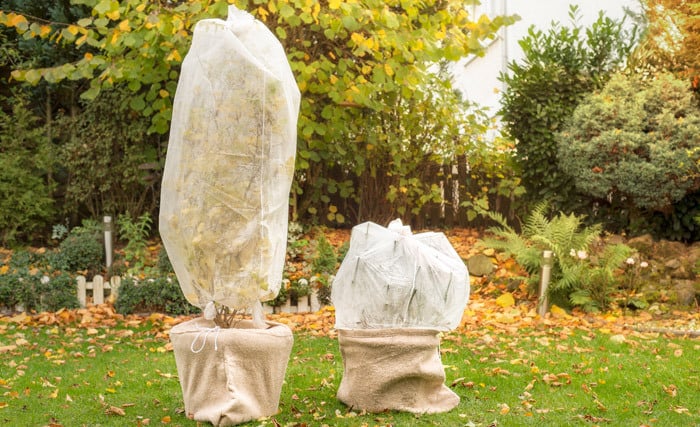How to Protect Trees and Plants from Cold and Frost Damage
Cold weather, snow, and frost can wreak havoc on plants and trees. Although most species are most susceptible to cold or frost damage when they’re young, the elements can affect both new and old growth. Certain species are also more prone to damage than others, so they require even more care. These typically include:
- Tropical and subtropical plants
- Citrus
- Jacaranda
- Oleander
- Catalpa
- Eugenia
Planning for Cold Weather
Those who live in cooler climates can always plan for future cold snaps and overnight frosts. Even in warmer climates, most of these events are easily forecasted and tracked by modern weather stations. In cases like this, damage prevention is your utmost goal. Thankfully, there are plenty of steps you can take to help protect plants and trees from upcoming bouts of cold weather, frost, or snow.
Water and Mulch
Remember – soil temperatures in the winter are generally higher than the air outside. Ensuring your plants have remained well-watered throughout the year is the first step in planning for cold weather.
Moist soil actually provides better insulation than dry soil. Snow will help with insulating plant roots, too, as well as keeping the soil moist, but you can also scatter several inches of wood mulch around newly planted trees, plants, and shrubs to help insulate it even further. When doing so, make sure to leave six inches of uncovered soil around the tree, shrub, or plant. Not only does this prevent unwanted root formations, but it also prevents nuisance wildlife from nesting in your yard.
Prune for Prevention
Strategic pruning of trees, shrubs, and even large plants can go a long way in preventing damage from frost or snow. Focus on eliminating weak branch attachments and leaders, as these can easily snap off due to snow cover. In some cases, falling limbs or branches can even cause damage to other parts of your property or home.
Choose Plants and Trees That are Weather-Resistant
If you live in a climate that regularly experiences cold weather, frost, or freezing temperatures, it makes sense to plan ahead and choose trees that are weather-resistant. Some popular options include:
- Birch
- Blue spruce
- White spruce
- Ironwood
- Austrian pine
- Hickory
- Japanese maple
- Bald cypress
- White oak
Some of the most popular weather-resistant plants include:
- Geranium
- Aster
- Hydrangea
- Winterberry
- Holly
- Primrose
- Hosta
- Snowdrop
- Catmint
- Boxwood hedge
Prune for Prevention
Strategic pruning of trees, shrubs, and even large plants can go a long way in preventing damage from frost or snow. Focus on eliminating weak branch attachments and leaders, as these can easily snap off due to snow cover. In some cases, falling limbs or branches can even cause damage to other parts of your property or home.
Choose Plants and Trees That are Weather-Resistant
If you live in a climate that regularly experiences cold weather, frost, or freezing temperatures, it makes sense to plan ahead and choose trees that are weather-resistant. Some popular options include:
- Birch
- Blue spruce
- White spruce
- Ironwood
- Austrian pine
- Hickory
- Japanese maple
- Bald cypress
- White oak
Some of the most popular weather-resistant plants include:
- Geranium
- Aster
- Hydrangea
- Winterberry
- Holly
- Primrose
- Hosta
- Snowdrop
- Catmint
- Boxwood hedge
Wrap Weak Plants and Trees
In some cases, weaker plants and trees that are more susceptible to cold weather can be wrapped for added protection. Nearly any material can be used, as long as it’s breathable – so avoid sheets of solid plastic. Bedsheets, burlap, and tarps are all great options. To avoid damage from the cover itself, try to minimize the amount of contact between the plant and the cover.
Guard Against Pests
While bugs and insects aren’t usually a problem during winter weather, other pests can still be an issue. Rabbits, voles, chipmunks, birds, and even deer have been known to feast on plants, bark, and twigs. If you experience problems with local pests, you might want to surround the affected plants and trees with metal hardware cloth – just make sure it’s tall enough to keep out the larger pests, too.
Taking Action After Frost or Snow
While those who live in cooler climates can generally plan for extended periods of cold, snow, or frost, those in warmer climates don’t always have that advantage. In cases of sudden or unexpected cold weather, the only option is to launch a recovery effort.
Prune for Recovery
Don’t start pruning your trees, shrubs, or plants immediately after a snowfall or frost. Instead, try to hold off until spring. Oftentimes, the damage isn’t as bad as it seems. It’s quite common for new growth to emerge once the weather warms up. Any type of salvageable fruit should be harvested immediately. Unless it’s rotten, most will still be usable in some form or another.
Stay Off Your Lawn
Try to minimize foot traffic on your lawn, especially when snow is still melting. Too much weight on a recently saturated lawn can damage the root systems underneath – especially for new growth.
Be Patient
Remember to remain patient after an unexpected frost or snowfall. Acting out of panic often results in mistakes, so don’t take any drastic actions just yet. If possible, try to wait it out and see what spring has in store for you and your plants – you might be surprised.
If the cold and frost end up being too much or you feel you need a hand in any way, top lawn care professionals are standing by in your area to lend a hand. By reaching out to us at lawncare.net, you’ll find the top Pros in the business ready to lend a hand, and they’ll be sure to get your lawn ready for the Spring!

